
Dance Festivals in Toyama, Tokushima, and Yamagata Prefectures
Guideto Japan
Culture- English
- 日本語
- 简体字
- 繁體字
- Français
- Español
- العربية
- Русский
Dancing in the Streets
Summertime in Japan is the bon odori season. Dancers circling in unison a yagura, an elevated platform where musicians play, is a common sight. But many bon odori take the form of nagashi-odori, or dance parades.
Dance parades begin and end at fixed points, and dancers follow a set of choreographed moves. Folk tunes are played, and dancers move through the neighborhoods clad in traditional outfits that lend each event a distinctive air. Here are three dance parades that are particularly impressive.
Owara Kaze no Bon
(September 1–3, Toyama, Toyama)
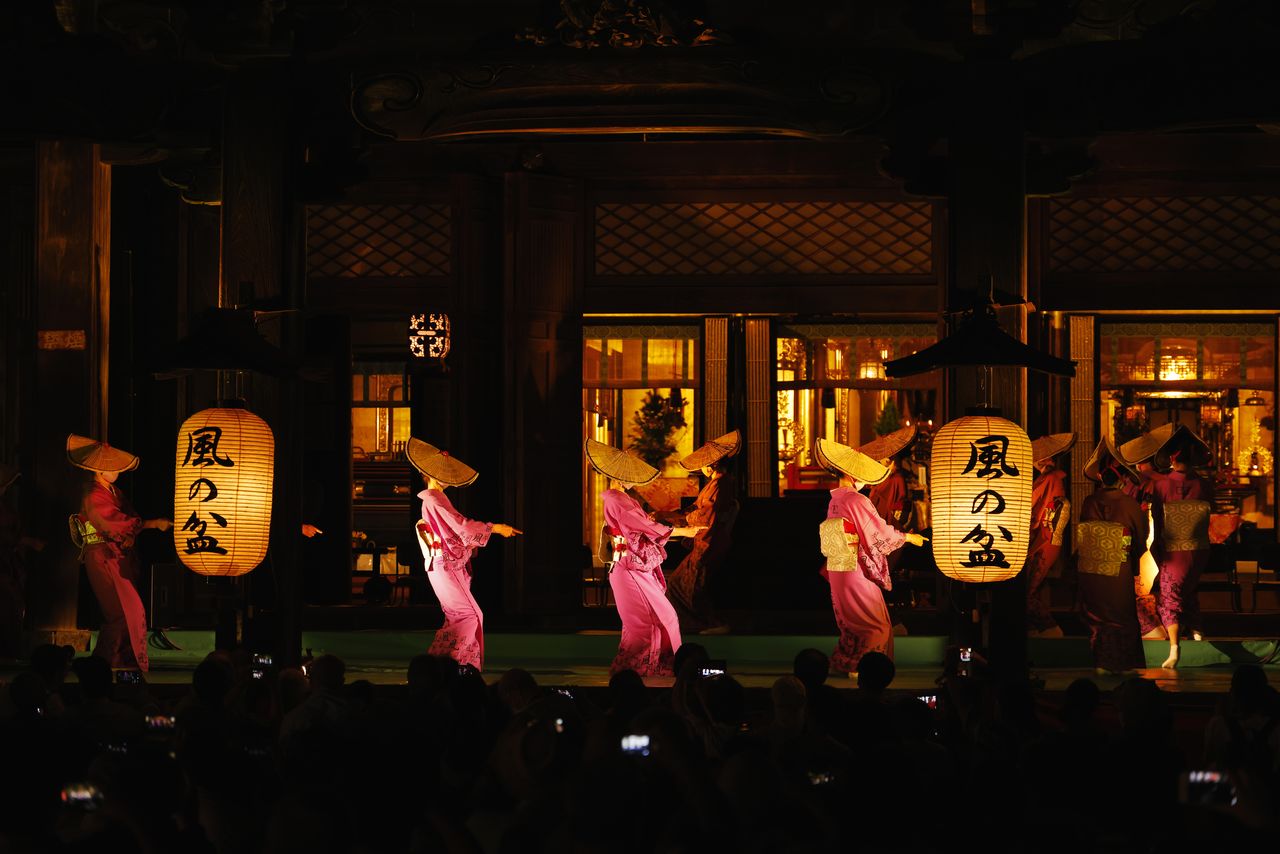
Dancers, their faces obscured by woven straw bonnets, perform wordlessly, but their outstretched fingers convey a message. (© Haga Library)
A passage from the 1985 novel Kaze no bon koi uta (The Love Song of Kaze no Bon), by Takahashi Osamu, aptly describes the festival’s atmosphere: “When the lanterns come aglow and the sound of the kokyū is in the air, the kaze no bon night grows late.”
A narrow street winds uphill along stone walls on the opposite side of the Ida River, south of Etchū Yatsuo Station on the JR Takayama main line. In the Yatsuomachi-Suwamachi neighborhood on a plateau above the town, traditional homes line the cobblestoned street, creating a picturesque scene rated among Japan’s “100 best” streets. The Owara Kaze no Bon takes place here and in the Yatsuo Fukushima neighborhood near the rail station.
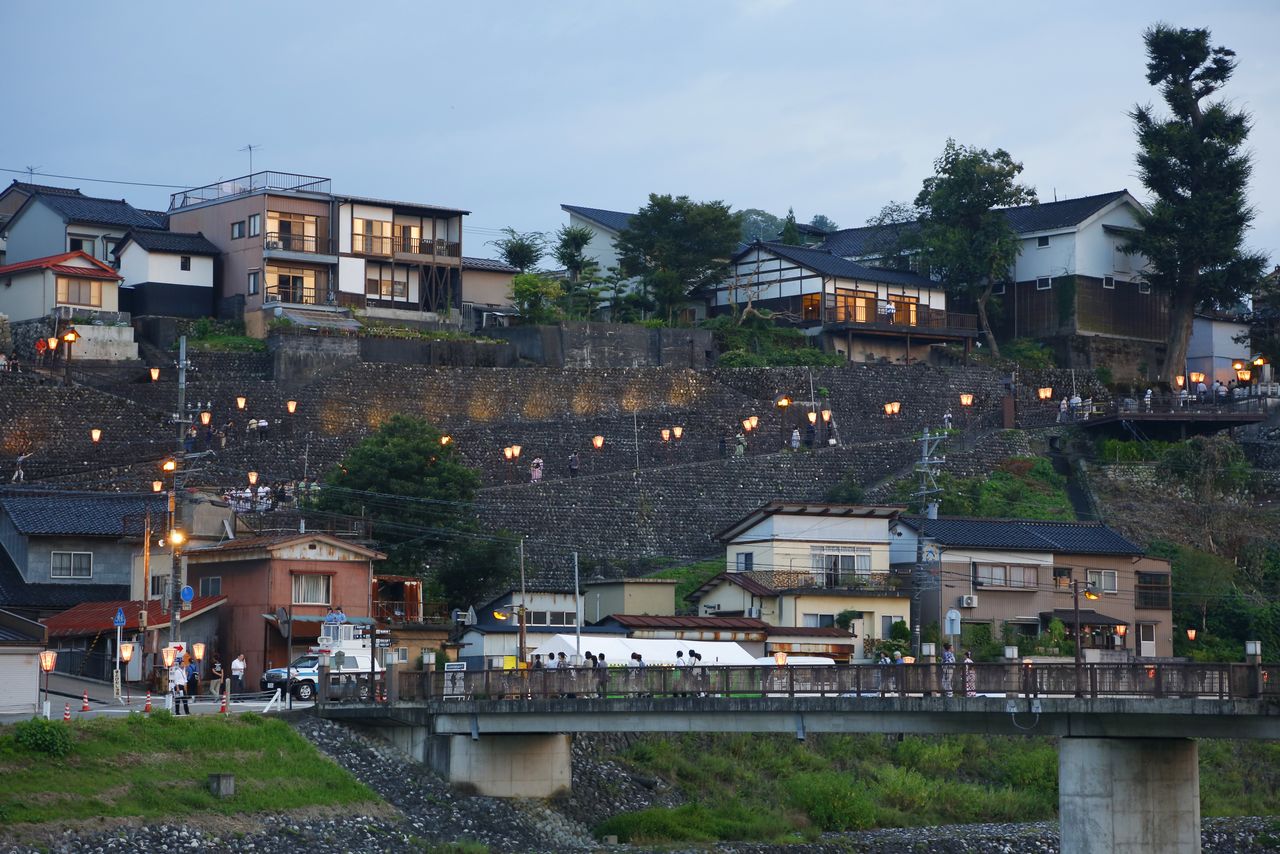
Lanterns light up a slope at dusk. (© Haga Library)
Although called Kaze no Bon, the festival takes place after the summer bon period. In the dialect of the region, the demarcation of the seasons is called bon. According to the traditional Japanese calendar, the autumn period 210 days after risshun, the beginning of spring, is said to be a blustery time, with typhoons an often occurrence. The festival originated 300 years ago with the hope of belaying the kaze, the strong winds that would damage the rice crop before harvest time, and to pray for a bountiful harvests.
The Yatsuo Fukushima area is home to about 2,000 residents, but the Kaze no Bon dance attracts more than 200,000 visitors over the three days of the festival. Strict rules—no crossing the road in front of the dancers, no viewing from the road, no flash photography—preserve the veil of night that is an important part of the event’s mystique.
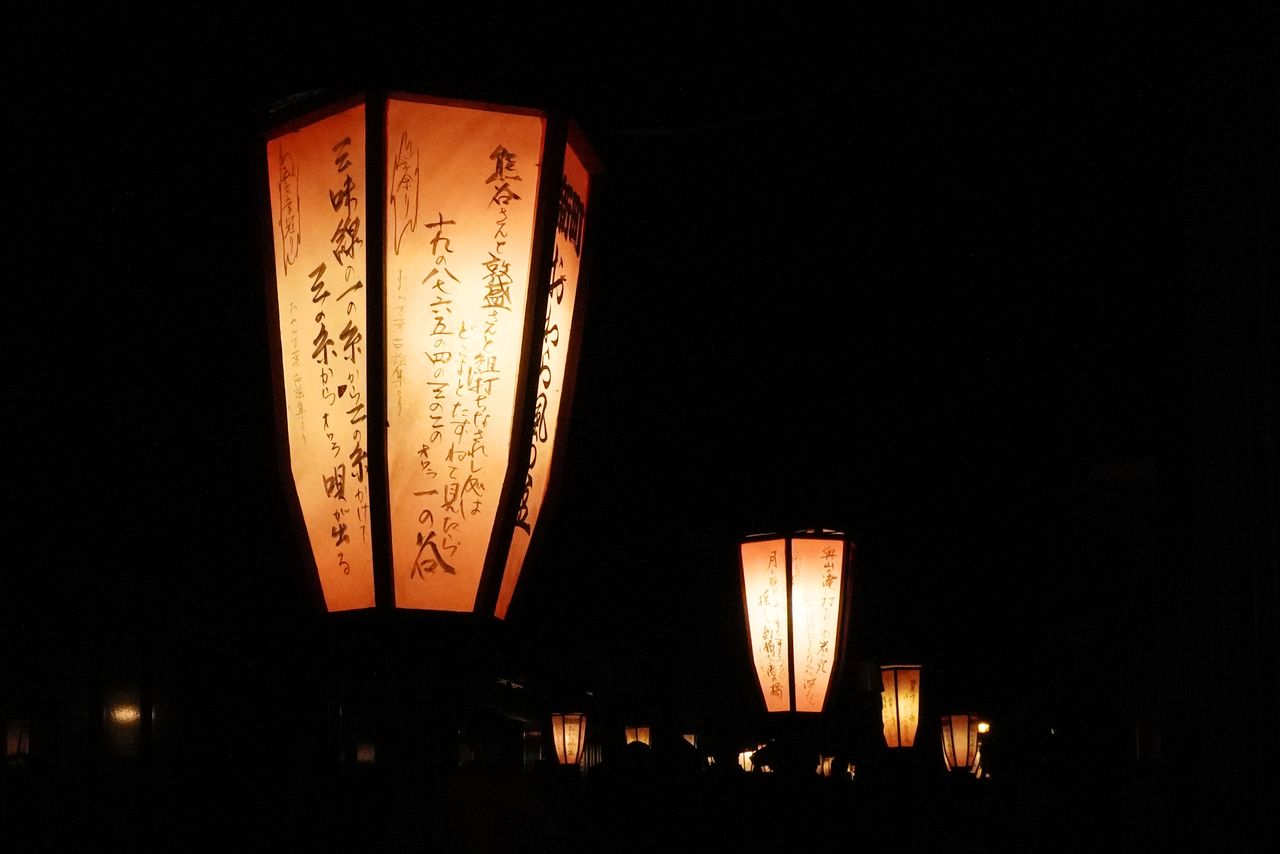
In the absence of streetlights, lanterns provide the only illumination. (© Haga Library)

A couple dance to a ballad about unrequited love. (© Haga Library)
As night falls, the crowd of spectators grows and shamisen begin to play. Groups of men and women clad in yukata dance in the street as they slowly proceed along the course. The women’s elegant dancing contrasts that of the men’s more dynamic style. In open spaces, the men and women pair to dance in sensuous displays of movement.
Singers and musicians follow behind the dancers. The plaintive sound of the kokyū, a traditional string instrument played with a bow, accompanied by shamisen fills the air. The kokyū’s high-pitched tone harmonizes beautifully with the neighborhood’s charm and the graceful dancing.

The sounds of shamisen and kokyū accompany the dancing. (© Haga Library)
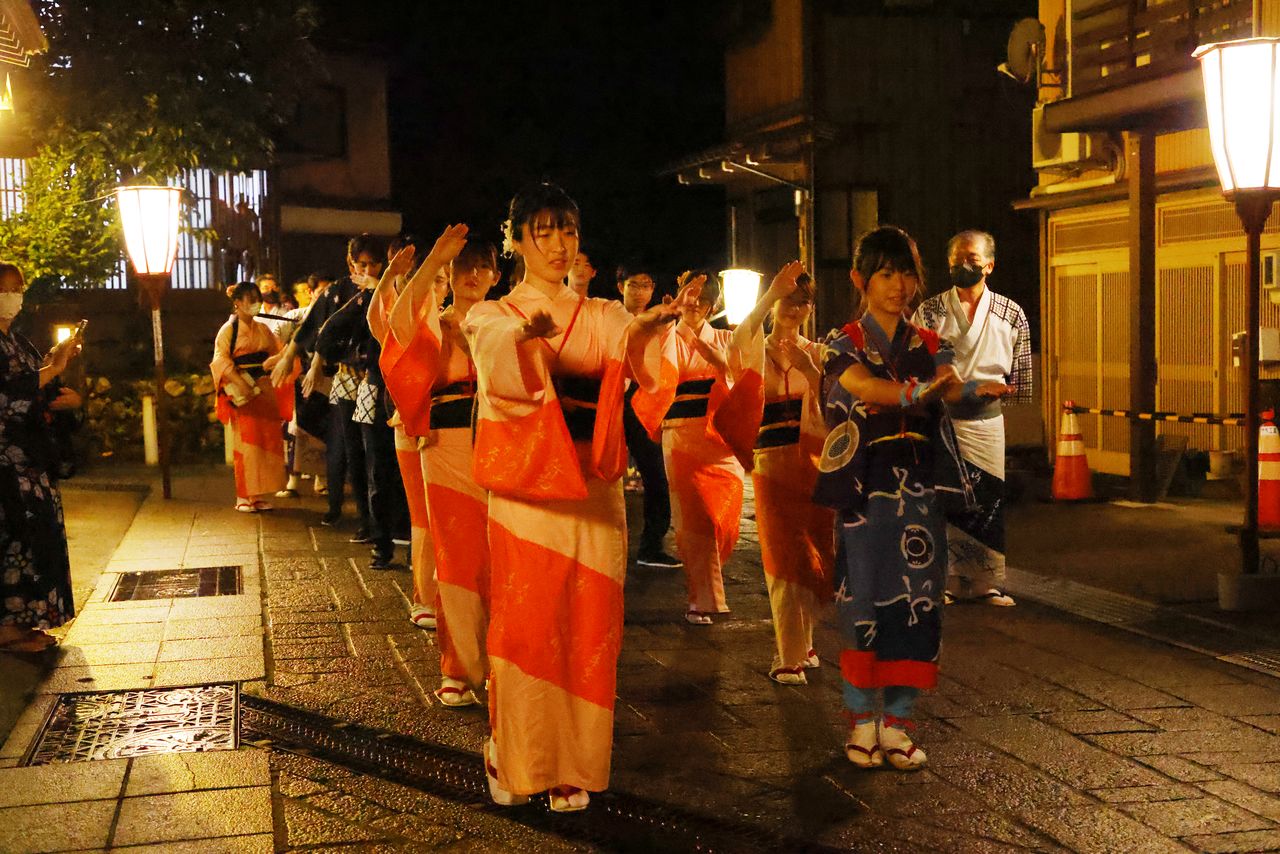
Only local residents who are single and under 25 years old are allowed to take part in the dance. (© Haga Library)
Large tour groups begin dispersing at around 11:00 pm and a hush descends on the town. Only a handful of spectators remain to watch the spectacle late into the night. The dancers, who have hidden their features behind straw bonnets, reappear, their faces now visible. It is hard to imagine that people so young and innocent-looking have been dancing so seductively. That aspect, to me, is the real pleasure of staying behind until dawn.
In each district, dancers fill the streets at whim, and the event continues until daybreak. When the overnight visitors board an early train to return home, dancers from the Fukushima neighborhood perform a farewell dance on the station platform.
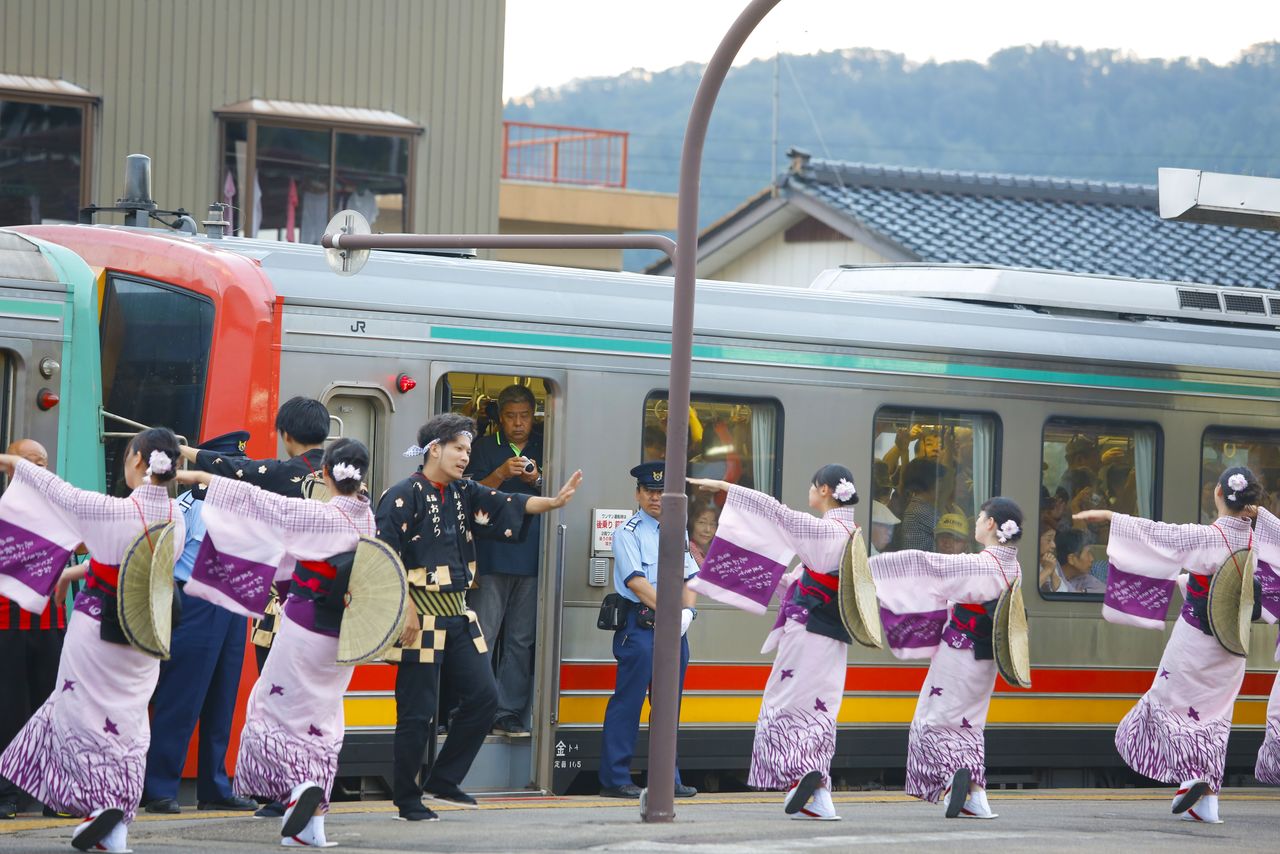
Sending visitors off after a night of dancing. (© Haga Library)
Awa Odori
(August 12–15, Tokushima, Tokushima)
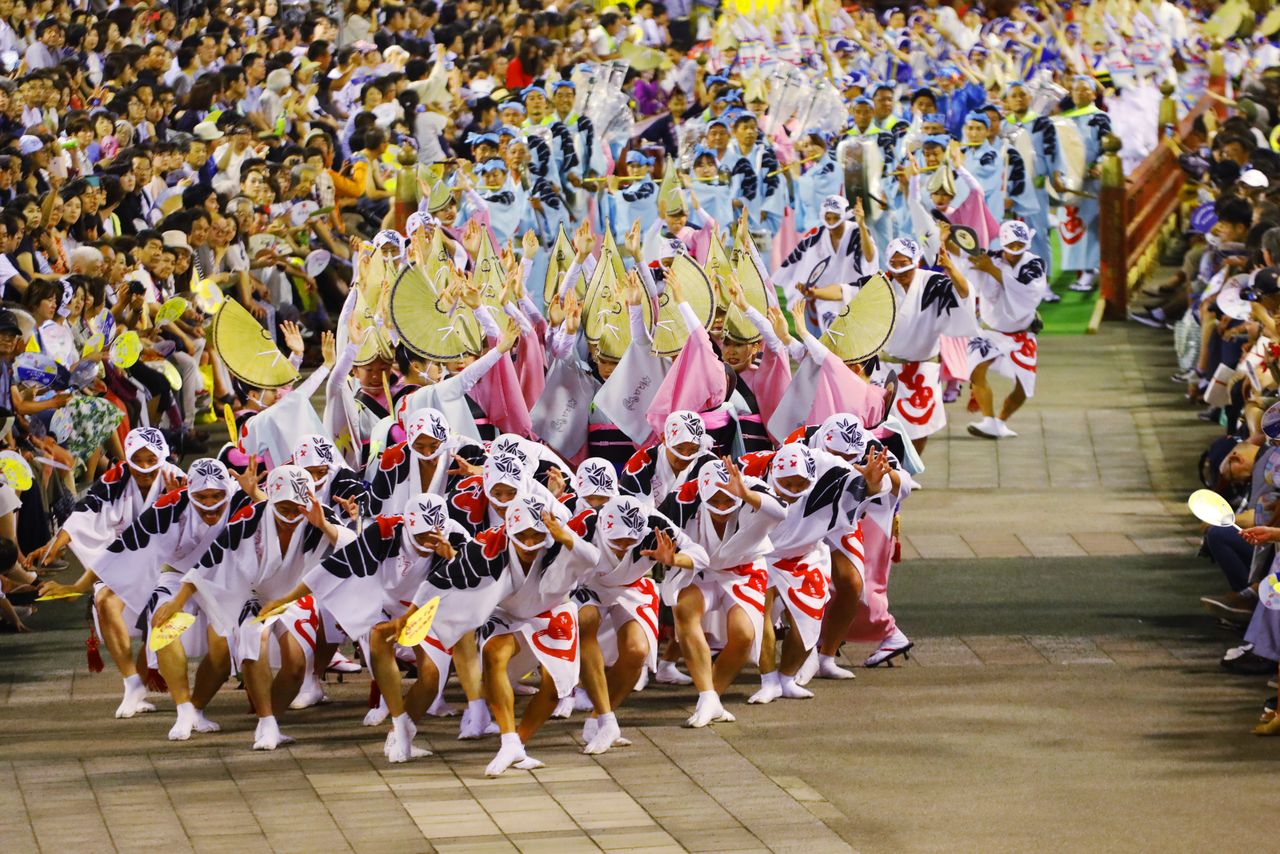
Each group performs a different dance; every performance a display of imaginative choreography. (© Haga Library)
Awa Odori originated in 1586 as a celebration of the completion of Tokushima Castle. Townspeople took to the streets for three days of dancing and carefree mingling, without regard for rank or station. The event later merged with the bon odori tradition of honoring departed ancestors and developed into street parade form. The Awa Odori is known as one of Japan’s most animated festivals.
As trains pull in to JR Tokushima Station and discharge passengers, the air is filled with the sound of shamisen playing. The one million people, quadruple the city’s population, who visit the Awa Odori every year are full of anticipation to see the dance parade take place along the main street. There are also four designated spectator areas with seating both paid and free of charge, and plenty of opportunities to catch—and join in on—impromptu dancing that breaks out in the streets. Over the four days of the Awa Odori, the entire city pulses to the rhythm of this lively event.
More than a thousand dance groups, called ren, each with 20 to 100 members, perform. At the spectator areas with paid seating, the dancing takes place between 6:00 and 10:00 pm every evening. It is a thrilling sight to see famous ren with talented dancers appearing one after the other, each group showing off their fancy dance steps.
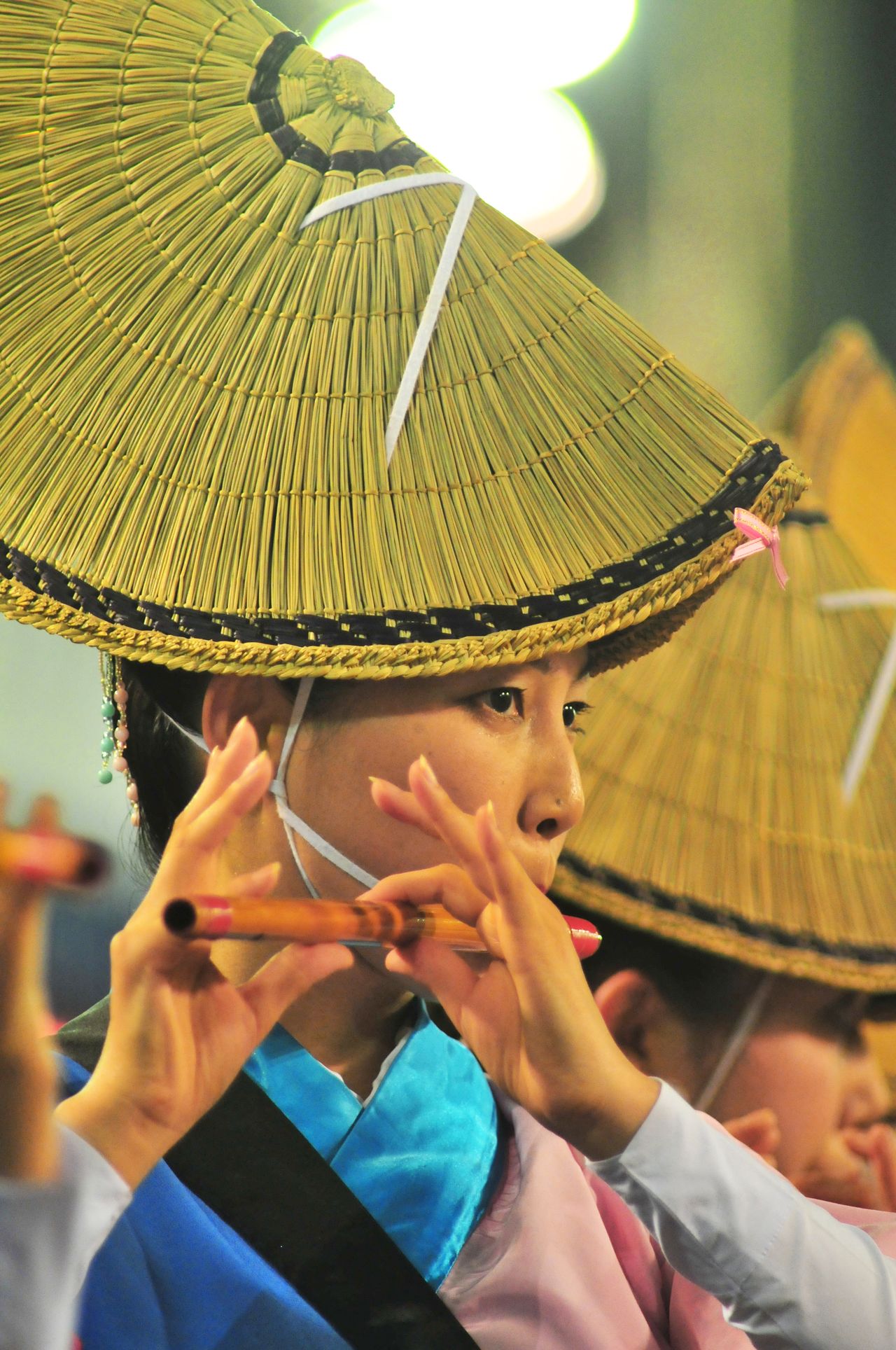
Shamisen, flutes, small gongs, and taiko drums provide the musical accompaniment. (© Haga Library)
Once the music starts, female dancers appear, wearing woven straw bonnets and colorful yukata, hands swaying gracefully. They are followed by groups of male dancers, who prance about energetically. All the dancers are smiling and cheerful, obviously taking to heart the famous phrase associated with the Awa Odori: “Some fools dance, and some fools watch. You’re a fool either way, so why not dance?”
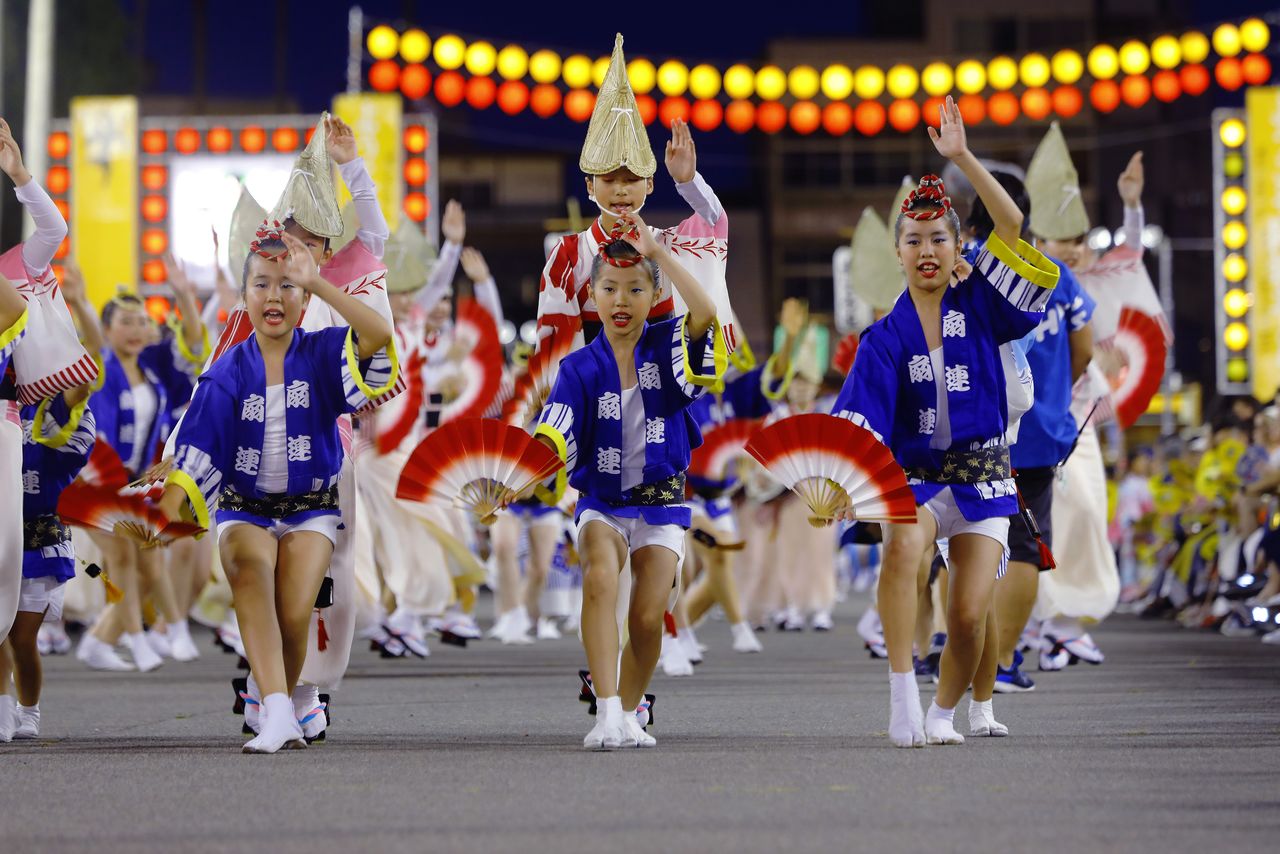
Anyone can join in the fun of the Awa Odori. (© Haga Library)
The climax of the event at the Minamiuchi-machi site features a thousand performers from 14 ren. Dancers pour in between the spectator stands on both sides of the street in an unending wave. The energy and liveliness of the dancing are on a par with that of Brazil’s Rio Carnival.
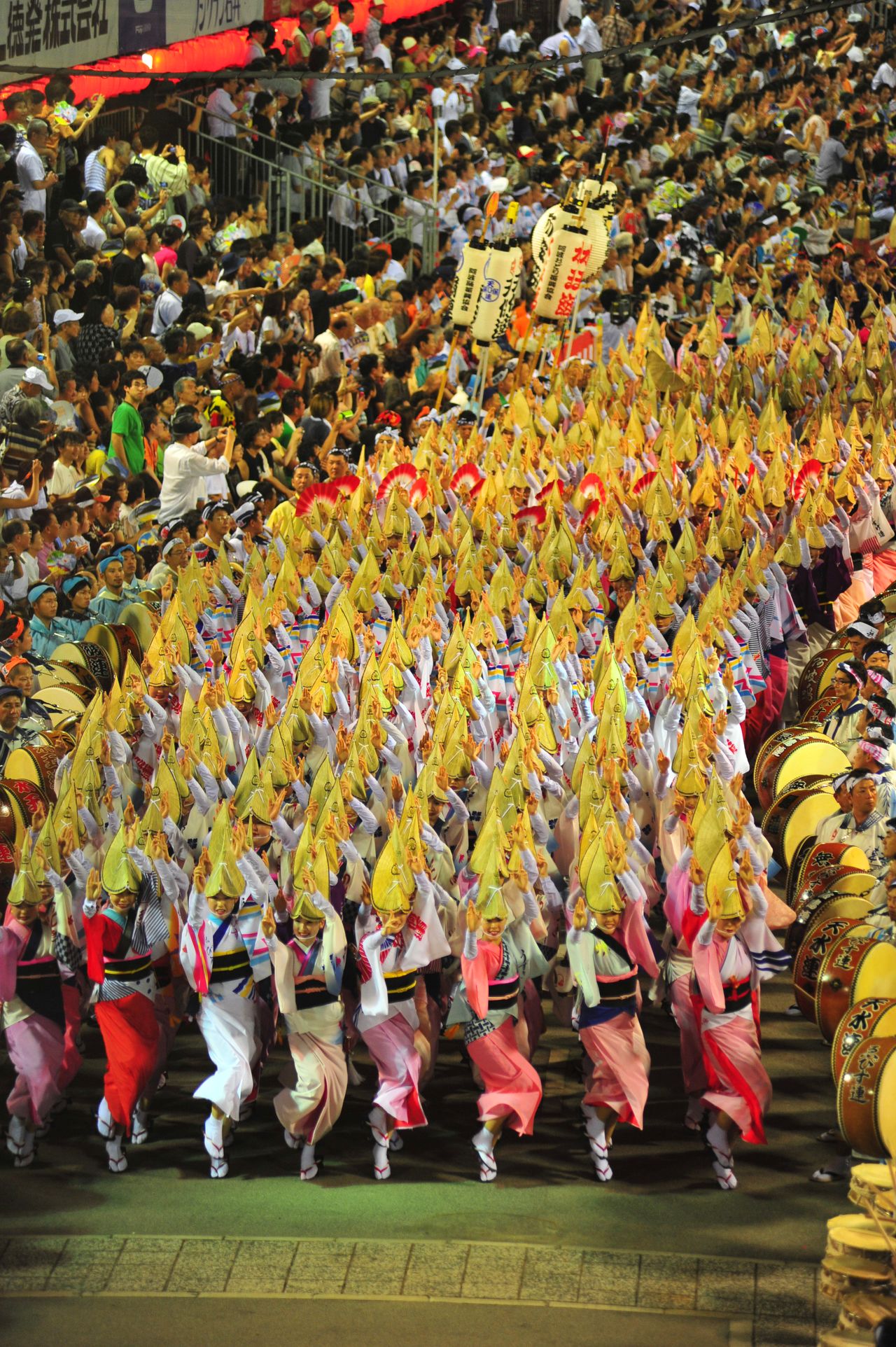
The Awa Odori ends with the sō odori grand finale. (© Haga Library)
Yamagata Hanagasa Matsuri
(August 5–7, Yamagata, Yamagata)
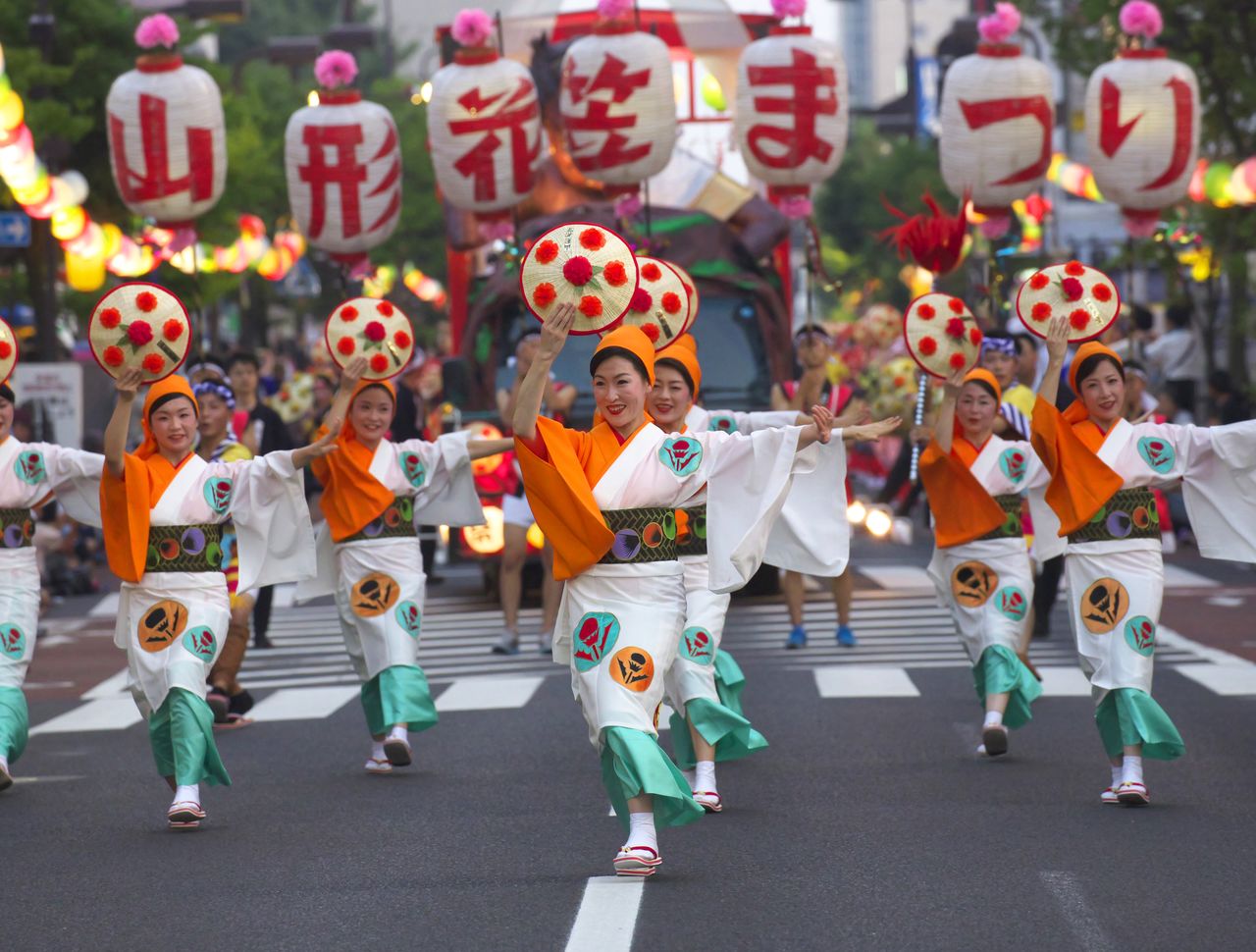
The Seichō Hanagasa Odori Kunpū Mogamigawa women’s dance has been presented every year since it was first performed in 1963. (© Haga Library)
Hanagasa Matsuri dancers hold woven straw hats decorated with benibana, blossoms of the safflower, high above their heads. The decorations give the festival its alternate name, the Benibana Odori. Dancers parade in the street to the sound of the rhythm of the Hanagasa Ondo, chanting “yassho makasho.”
There are 160 groups who carry on the dance’s legacy, and their moment in the spotlight comes during the three-day Hanagasa Matsuri. The 14,000 dancers of the Hanagasa Odori Preservation Society line up on the 1.2-kilometer long route at dusk, dancing in a throng that parades unbroken for over three hours.
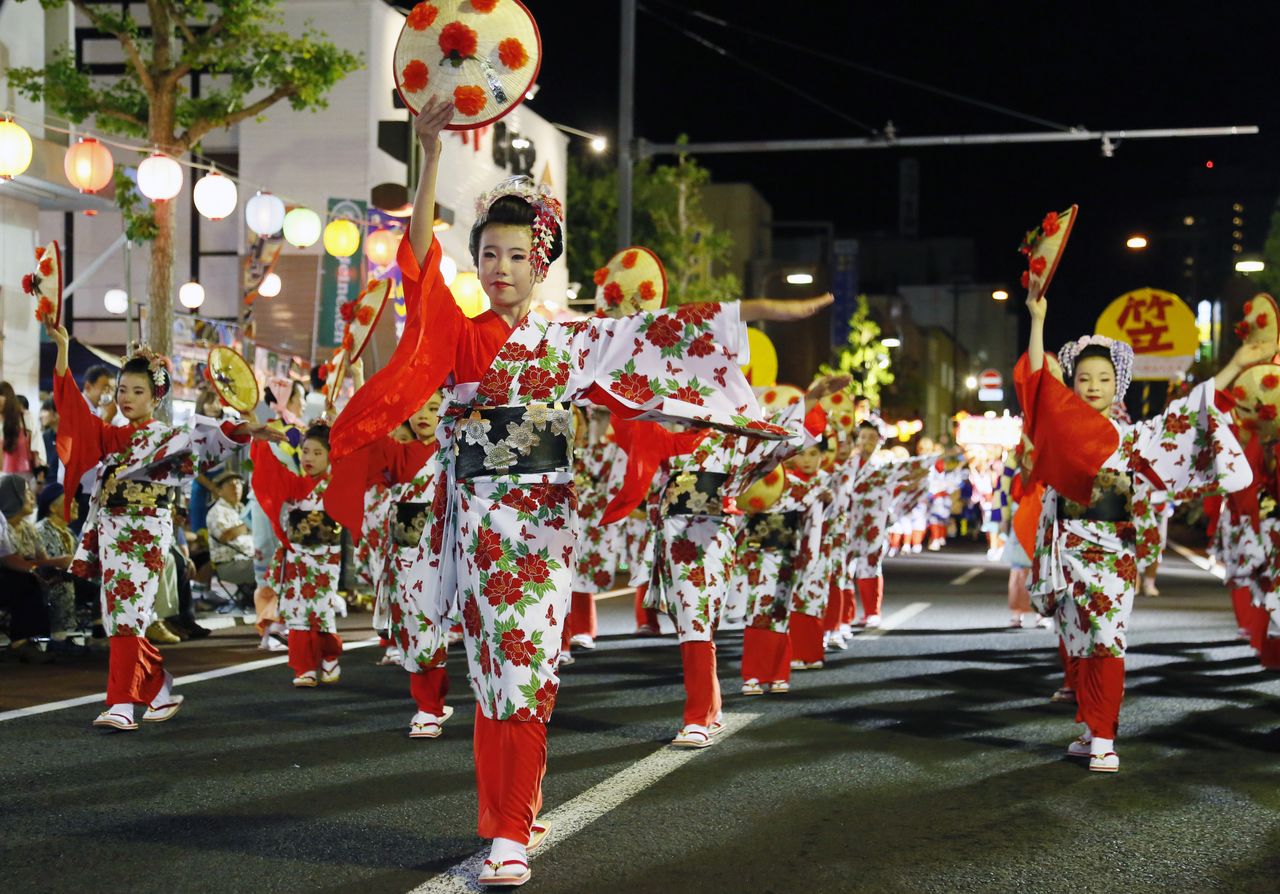
Dancers move in perfect unison to tunes singing the praises of local places and specialties. (© Haga Library)
The dance parade is a relatively new invention, having started during the Taishō era (1912–26). The Hanagasa Ondo festival tune was originally a dontsuki uta, a type of work song sung to help laborers keep an even rhythm as they dug a reservoir. To celebrate the completion of the reservoir, moves were created to accompany the tune, and the new creations was named Hanagasa Ondo. The dancing developed into a street parade, which eventually evolved into today’s gorgeous spectacle.
The seichō style of traditional dancing expresses the beauty of nature and the human achievements also celebrated in the Hanagasa Ondo. The choreography of Kunpū Mogamigawa, with elements of Nihon buyō, classical Japanese dance, is known as “the women’s dance,” while the bold Zaō Gyōkō dance style is called “the men’s dance.”
The “hat-twirling dance” of Obanazawa, birthplace of the Hanagasa Ondo, is another sight not to be missed. This dance incorporates the digging movements of the song’s origin, and large hats similar to those used when the dance was first created are twirled energetically. Each dance group has also developed distinctive moves that contribute to the mood of the event.
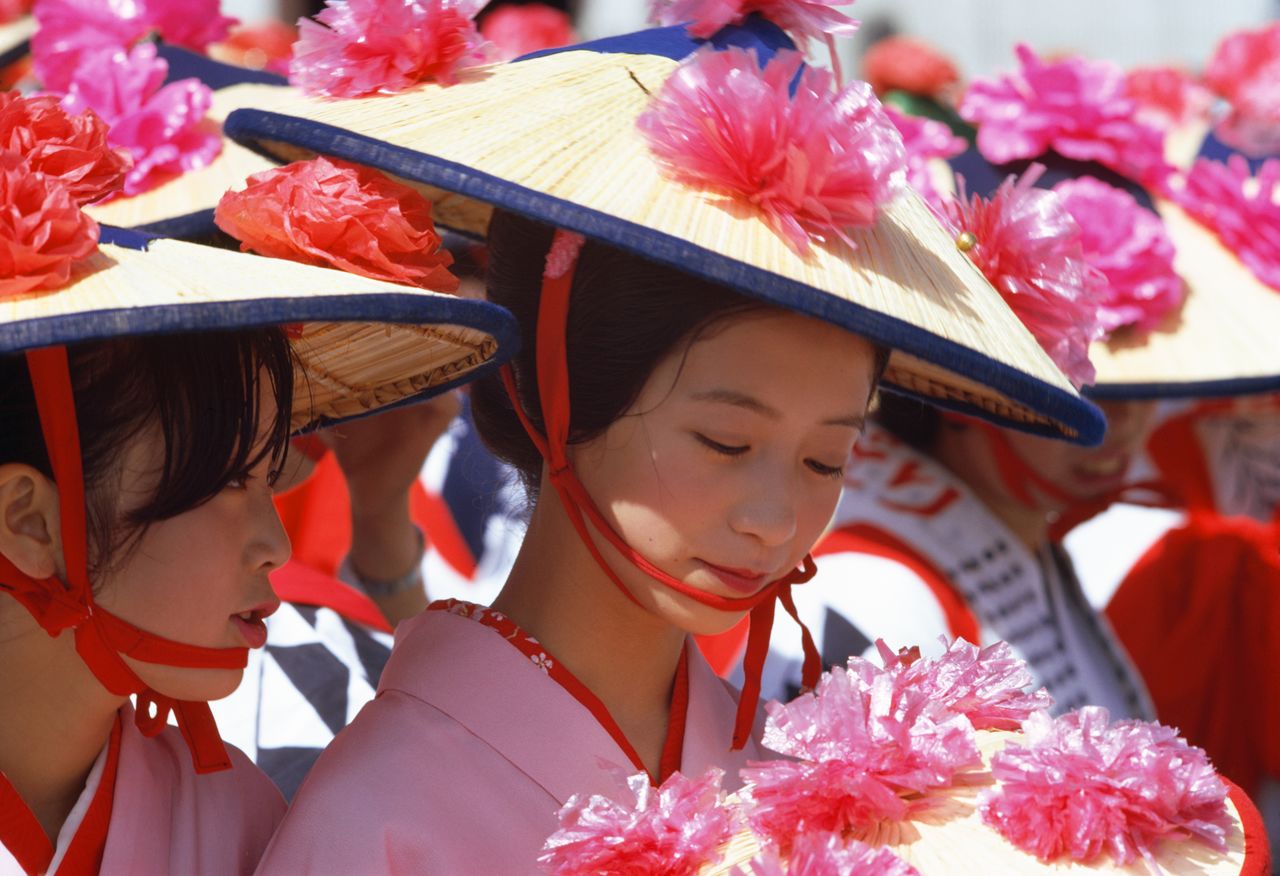
The Obanazawa Hanagasa Matsuri takes place in Obanazawa, home of the Hanagasa Matsuri held on August 27–28. (© Haga Library)
The artificial flowers adorning dancers’ hats today are modeled on benimochi, compressed, dried discs of fermented benibana petals from which the red dye beni is made.
Benibana cultivation in the area began in the Muromachi period (1333–1568). The soil and climate of the Mogami River basin are well-suited to growing the flowers, and during peak production years the region accounted for nearly half of all benibana grown in Japan. In particular, the pigment in the petals of flowers grown in the Mogami region inland in the north of the prefecture produced the finest beni lip coloring and was said to be worth as much as gold. Benibana, which contributed so much to local prosperity, is the pride of Yamagata even today.
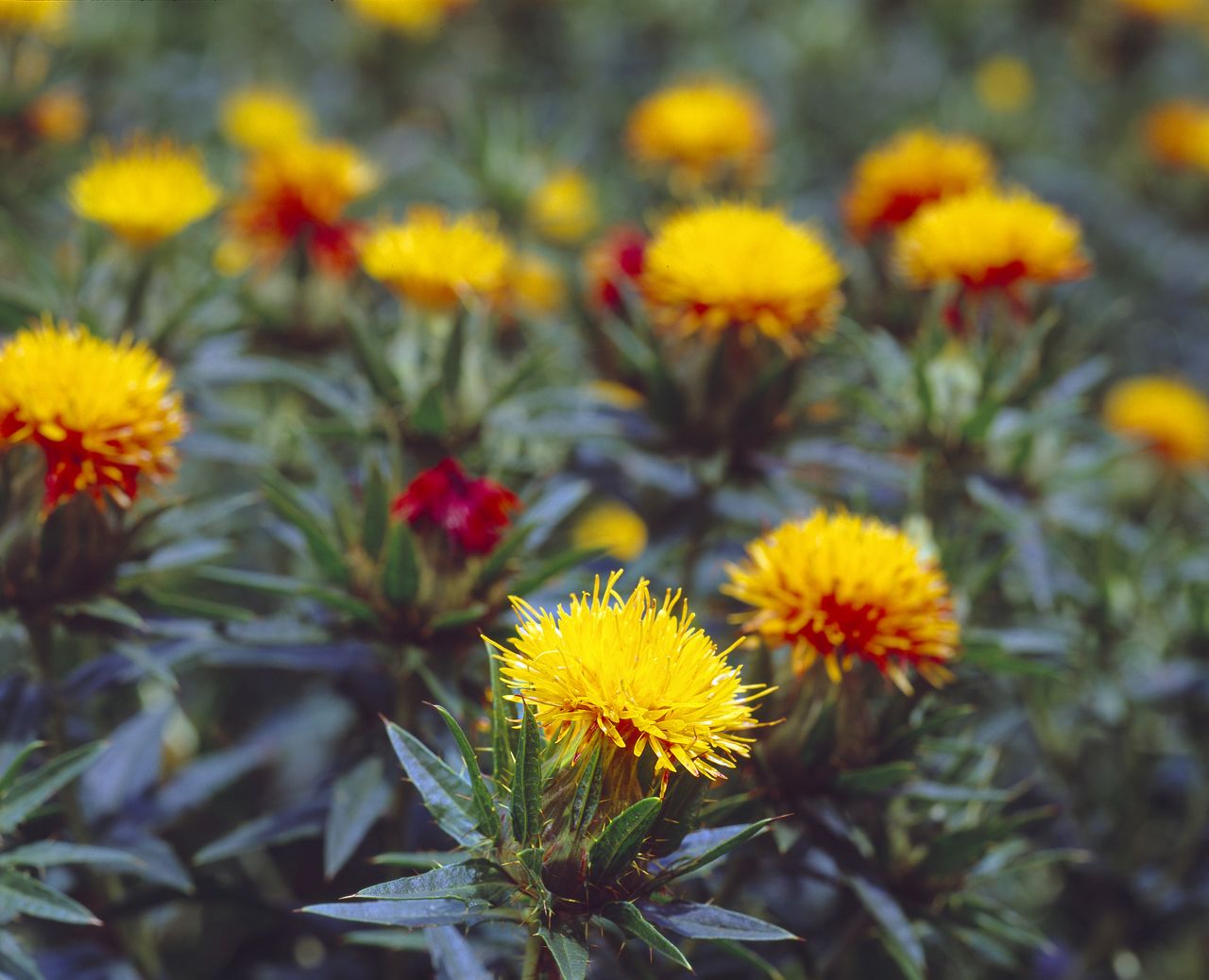
Benibana is the official Yamagata prefectural and municipal flower. The flowers were precious, each producing only a tiny amount of the pigment used to make beni lip coloring. (© Haga Library)
(Originally published in Japanese. Dates given are those on which the festivals are usually held. Banner photo: Dancers of Yamagata’s Owara Kaze no Bon. © Haga Library.)